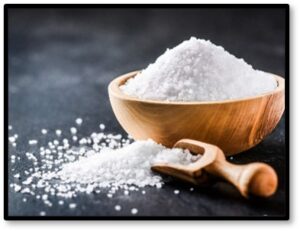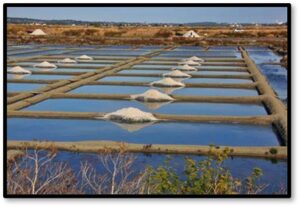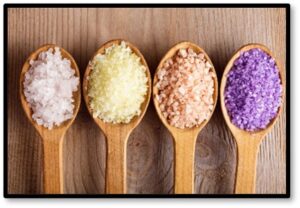Monday Author: Susanne Skinner
 Morton Salt is a kitchen staple. Most cupboards contain the familiar blue container with a little girl under an umbrella and the slogan “When it rains it pours.” Back in the day, salt began and ended with Morton’s.
Morton Salt is a kitchen staple. Most cupboards contain the familiar blue container with a little girl under an umbrella and the slogan “When it rains it pours.” Back in the day, salt began and ended with Morton’s.
Salt is an ionic compound with the chemical formula NaCl. It has a 1:1 ratio of sodium and chloride ions. It is a basic element of human and animal diets and a seasoning in food preparation.
Known as white gold, salt dates to the dawn of time and it is the only mineral humans and animals eat.
Where Does Salt Come From?
Salt forms in nature. We harvest it from the sea and mine it from layers under the earth. The saltshaker on our tables contains a mineral that boasts a long and amazing history. The earliest known salt harvest took place around 6000 BC at Lake Yuncheng, in the Chinese province of Shanxi.
Mining Salt
One of the oldest salt mines in the world is in Wieliczka Poland. Miners dug the first mine shafts in the 13th century and today the Wieliczka Salt Mine, is a Polish historic monument and UNESCO World Heritage Site.
 The mine has nine levels with two thousand chambers branching out in horizontal passages300 kilometers long and 327 meters deep.
The mine has nine levels with two thousand chambers branching out in horizontal passages300 kilometers long and 327 meters deep.
Miners spent so much time working underground they began carving statues into the mine’s salt walls, eventually creating an underground lake, four chapels, a cathedral and even a chandelier—all from salt.
In 2007 the mine closed for commercial use but remains open as a tourist attraction.
Harvesting Sea Salt: The Guérande Salt Marshes
The Guérande salt marsh produces two of my favorite salts, sel gris and fleur de sel. Stretching across 5,000 acres in southern Brittany, these wetlands sit at the mouths of the Loire and Vilaine Rivers and the Atlantic Ocean.
 Sel gris, or gray salt, is the more common coarse salt, harvested every day during the summer when the salt crystalizes and is deposited in the clay. A worker uses a wooden rake called a las, pushing the salt to the edges of the marsh pond where it is harvested by hand.
Sel gris, or gray salt, is the more common coarse salt, harvested every day during the summer when the salt crystalizes and is deposited in the clay. A worker uses a wooden rake called a las, pushing the salt to the edges of the marsh pond where it is harvested by hand.
Pure white fleur de sel or flower of salt is more expensive; a delicate and intense fine crystal with a hint of violet. A small amount enhances sweet and savory dishes. It adds nuance and flavor to baked goods and considered a finishing salt rather than a cooking salt.
Guérande salt is rich in minerals and it remains untreated and unrefined. Accept no imitations.
The Value of Salt
The spread of civilization elevated salt to one of the world’s most important commodities for trading and currency. Cakes were cut, weighed and marked, assuring consistency in size and value for transactions among tribes.
During the sixth century an ounce of salt equaled an ounce of gold among merchants in Iberia and Ethiopia. The Mayan culture used slabs of rock salt as currency and it was a preservative for meats.
During Roman times it was so valuable soldiers were often paid in salt. The word salary derives from sal—Latin for salt. If a soldier’s performance declined he often found his paycheck reduced, giving us the phrase not worth his salt.
The Importance of Iodine
The thyroid gland uses Iodine to produce thyroxine. Since it isn’t synthesized in our bodies, we need to get it from food. Ocean-caught or ocean-farmed fish and shellfish are naturally rich in iodine, along with milk, yogurt, and cheese. But two billion people worldwide still suffer from insufficient iodine. A serious iodine deficiency causes goiters, an enlargement of the thyroid gland.
In the 1920s, the Great Lakes and Appalachian regions began adding iodine to salt and flour when goiters reached epidemic proportions. Four years later the United States began fortifying salt by adding a dollar’s worth of iodine to each ton of processed salt.
In 1990 only 25% of the world’s households used iodized salt but today 90% of the US population uses it. Most adults require 150 mcg of iodine per day.
A New Generation of Cooking
Specialty Salts have become an industry unto themselves. Although salt is inexpensive and widely available, it also boasts a luxury line. I admit to owning a few (see sel Guérande above) and attest to their nuances and flavors.
 Salt is a seasoning, not a spice. Though it sits side by side with spices, it is not organic, i.e., seeds, bark, roots and leaves. Salt is a mineral; in cooking it is a seasoning condiment. I will out myself right here and admit I do not use Morton’s salt for anything. Ever. It has too many additives in addition to the iodine, and I get that in my diet. My go-to favorites include Diamond Crystal Kosher Salt and Maldon Flake Salt.
Salt is a seasoning, not a spice. Though it sits side by side with spices, it is not organic, i.e., seeds, bark, roots and leaves. Salt is a mineral; in cooking it is a seasoning condiment. I will out myself right here and admit I do not use Morton’s salt for anything. Ever. It has too many additives in addition to the iodine, and I get that in my diet. My go-to favorites include Diamond Crystal Kosher Salt and Maldon Flake Salt.
Used in both sweet and savory dishes, salt enhances and intensifies flavors. But not all salt is created equal and some are better than others. The most readily available include kosher salt, sea salt, and Himalayan salt, along with many specialized variations.
And if you have deep pockets, try the most expensive salt in the world: jukyeom, or bamboo salt from Korea sells for around $9.00 an ounce.
A Thousand Uses
Salt’s versatility extends way beyond the kitchen. According to the Salt Institute, it has over 14,000 uses. Read more about it here, and at Saltworks, my favorite purveyor of all things salt. For a complete history of salt, check out Mark Kurlansky’s Salt: A World History.
